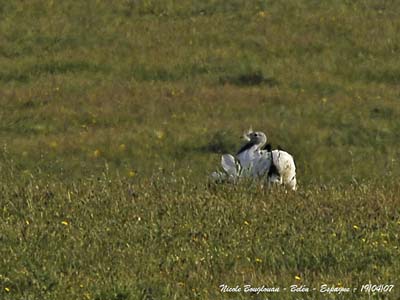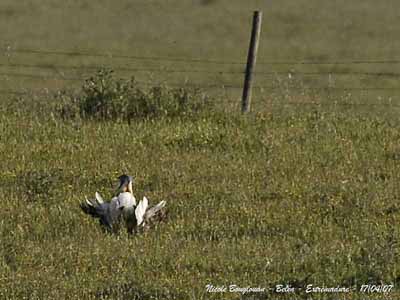
Great Bustard
Otis tarda
Otidiformes Order – Otididae Family
BIOMETRICS:
Length: M : 105 cm – F : 75 cm
Weight: M : 5,8 – 18 kg (sometimes more)
F : 3,3 – 5,3 kg
DESCRIPTION:
The Great Bustard is an important part of the Iberian steppes.
This large bird is unfortunately considered today as Vulnerable. The Spanish population is about 60% of the total world population, and protection by maintenance of low-intensity farming over large areas is necessary.

Adult male in breeding plumage has barred black and gold upperparts. There is a broad white patch on the closed wings. The tail is as back, with broad black subterminal band and white tip.
Underparts are white.
Head and foreneck are pale blue-grey, shading into white, and then bright chestnut on the lower neck and breast.
We can see long whitish barbs (120-150mm) on each side of the bill base. These long feathers appear at about 3 years of age, and regularly grow until about 6 years.
The bill is grey. Eyes are dark brown. The robust legs and the strong feet are dull olive-brown to grey.

The non-breeding male lacks the barbs, and shows pale grey neck and breast.
Female is duller in plumage, and much smaller than male.
The juvenile resembles adult female, but head and neck have more buff, and the bars are less distinct on the upperparts.
The young male breeds at 5-6 years, and the young female at 2-3 years.
This species may live up to 28 years.

We can find another race, Otis tarda dybowskii, present in SE Russia, Mongolia and NE China.
This one has paler grey head and neck, and more distinctly barred upperparts.
VOICE: SOUNDS BY XENO-CANTO
The Great Bustard is usually silent, but we can hear occasionally some deep grunts when the bird is alarmed or aggressive.
In breeding season, the male produces some booming, grunting and raucous noises. The female may utter some guttural calls near the nest.
Some sounds might be described as “eng” or “kleng”.

HABITAT:
The Great Bustard frequents flat or rolling open plains. In Spain, this species may be seen in cork-oak and olive-tree plantations.
They breed in grasslands and pastures which provide them insects and flowers in spring and summer. They mainly need lack of disturbances all year round.

RANGE:
The Great Bustard breeds in S and C Europe and across temperate Asia.
We can find populations in Spain (60% of the world numbers), Portugal, Hungary, Slovakia, Russia and Turkey.
The European birds are resident or dispersive, whereas the Asian birds are migratory, moving southwards in winter, but over limited distances.

BEHAVIOUR:
The Great Bustard feeds mainly on plant material and insects. It may sometimes take small mammals as rodents, chicks of other bird species and amphibians.
Cultivated plants are taken from late summer to winter, and then, green items are added from mid-winter into spring, and insects from spring into late summer.

Males and females form separated groups almost all year round, except during the breeding season.
During winter, the males establish a hierarchy within each group, performing violent fights during prolonged periods. They give stabs at neck and head of other males, involving sometimes serious injury.
This behaviour is typical of bustard’s species.

The courtship displays by the males are something spectacular. At the beginning of the breeding season, males and females gather at traditional leks where courtship displays occur.
The male performs the typical “wheel” in order to attract females. For that, he performs a complete transformation and his body becomes as “foam-bath”, that is the other name of these displays.



At this moment, the male resembles a white ball visible at several kilometres.
The male may keep this posture for some time, expecting for some female. He is silent during the displays.

Several males are displaying together at the lek, and females come to see them during several days before mating.

FLIGHT:
The Great Bustard in flight is often named “Flying fortress”. This bird is the heaviest flying bird in the world. The flight is powerful and majestic, with slow regular wing-beats. Head and neck are stretched out, whereas legs are held beneath the tail.
The Great Bustards are very conspicuous in flight, exposing the pure white underwing and underparts. They may reach speed up to 80km/hour.


REPRODUCTION:
Breeding season occurs in spring, with laying in May-June according to the region.
The nest is on the ground. It may be a scrape or not, occasionally lined with bits of grass and crop stems. It is concealed among the tall grasses.

The female lays 2-3 eggs. Incubation by female alone lasts about 25 days to one month. The chicks are precocial and leave the nest immediately. They are covered in pale buff streaked sepia down, providing them cryptic colour and good camouflage. If they are threatened, they remain motionless on the ground.
They are raised by female and fledge about 30-35 days after hatching. However, they reach the full size between 80 and 120 days of age. They still depend on their mother for about ten months.
DIET:
The Great Bustard feeds primarily on vegetal matter such as grass, legumes and crucifers (Brassicaceae), grains, flowers such as Taraxacum officinale and ripe grapes.
It also feeds on small mammals (rodents), chicks of other bird species, earthworms, butterflies, larvae and large insects such as grasshoppers and other similar. Lizards and amphibians are added to the diet, according to the season.

PROTECTION / THREATS / STATUS:
The Great Bustard is considered as Vulnerable.
Populations suffered decline due to fragmentation and loss of the habitat.
Changes in agriculture from traditional farming to more intensive practices play an important role in declines.
Collisions with power lines, illegal poaching and hunting which unfortunately still occur in some areas are great threats too.

This species is vulnerable to disturbances and needs large open areas with low-intensity farming, because pesticides and destruction of nests and chicks during crop treatment and harvesting are heavy threats for bustards.
Conservation and protection measures are on their way, and other in progress, in order to continue enjoying the presence of these wonderful birds in the open fields of their range.
Fr: Outarde barbue
All : Großtrappe
Esp : Avutarda Euroasiática
Ital : Otarda
Nd : Grote Trap
Russe : Дрофа
Sd : Stortrapp
Port : Abetarda-comum
Text and photographs by Nicole Bouglouan
Sources :
From the article « Fortalezas volantes » by Carlos Palacín, Doctor of Biology.
HANDBOOK OF THE BIRDS OF THE WORLD Volume 3 by Josep del Hoyo-Andrew Elliott-Jordi Sargatal - Lynx Edicions - ISBN : 8487334202
BirdLife International (BirdLife International)
Pájaros de España (JL Beamonte)